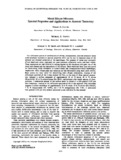Metal-silicate mixtures: Spectral properties and applications to asteroid taxonomy.

Metadata
Show full item recordAuthor
Cloutis, Edward A.
Gaffey, Michael J.
Smith, Dorian G. W.
St. J. Lambert, Richard
Date
1990-06-10Citation
Cloutis, E. A., M. J. Gaffey, D. G. W. Smith, and R. St J. Lambert. "Metal-silicate mixtures: Spectral properties and applications to asteroid taxonomy." Journal of Geophysical Research 95 (1990): 8323-8338. DOI: 10.1029/JB095iB06p08323.
Abstract
The reflectance spectra of combinations of olivine, orthopyroxene, and iron meteorite metal show systematic variations in spectral properties which can be used to constrain many of the physical and chemical properties of the assemblages. The presence of metal most noticeably affects band area ratios, peak:peak and peak:minimum reflectance ratios, and band widths. These parameters are also affected to varying degrees by the abundance and grain size of the metal and silicates and the composition of the silicates. Band width and band areas are useful for determining metal abundance in olivine+metal and orthopyroxene+metal assemblages, respectively. Mafic silicate grain size variations are best determined using band depth criteria. Band centers are most useful for determining mafic silicate composition. Analysis of the
reflectance spectrum of the S-class asteroid (8) Flora on the basis of these spectral parameters indicates a surface composed of approximately 50 wt % metal, 40 wt % olivine (Fa=35±10), 10 wt% orthopyroxene (Fs=30+35-25), and perhaps a few weight percent of clino· pyroxene. A substantial amount of the surface seems to consist of a fine-grained ( <45 μm
size) component. Analysis of the reflectance spectrum of the A-class asteroid (446) Aetemitas suggests a surface assemblage of approximately 35 wt % metal, 55 wt % olivine (Fa=20±10), 7 wt % clinopyroxene (Fs <17%), and 3 wt % orthopyroxene (Fs <45). A substantial fine-grained (<45 μm size) surface component is also indicated for this asteroid.
